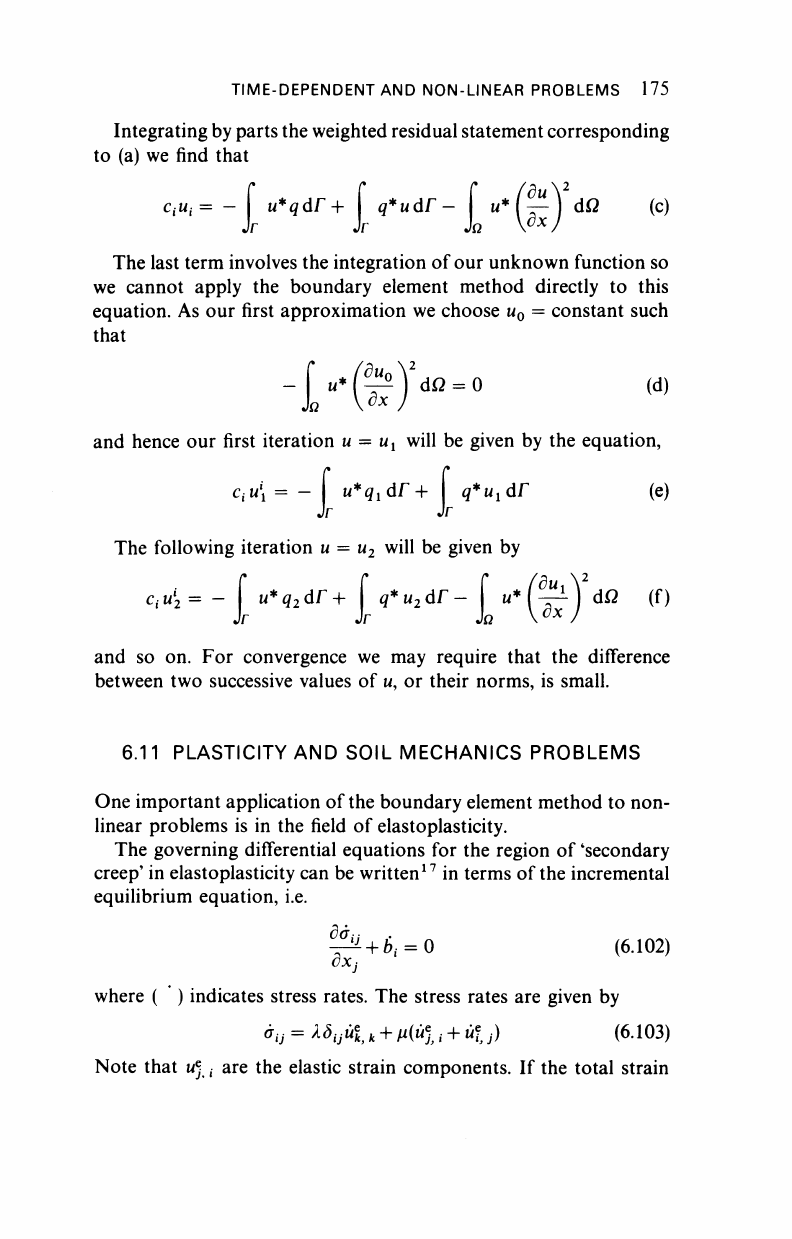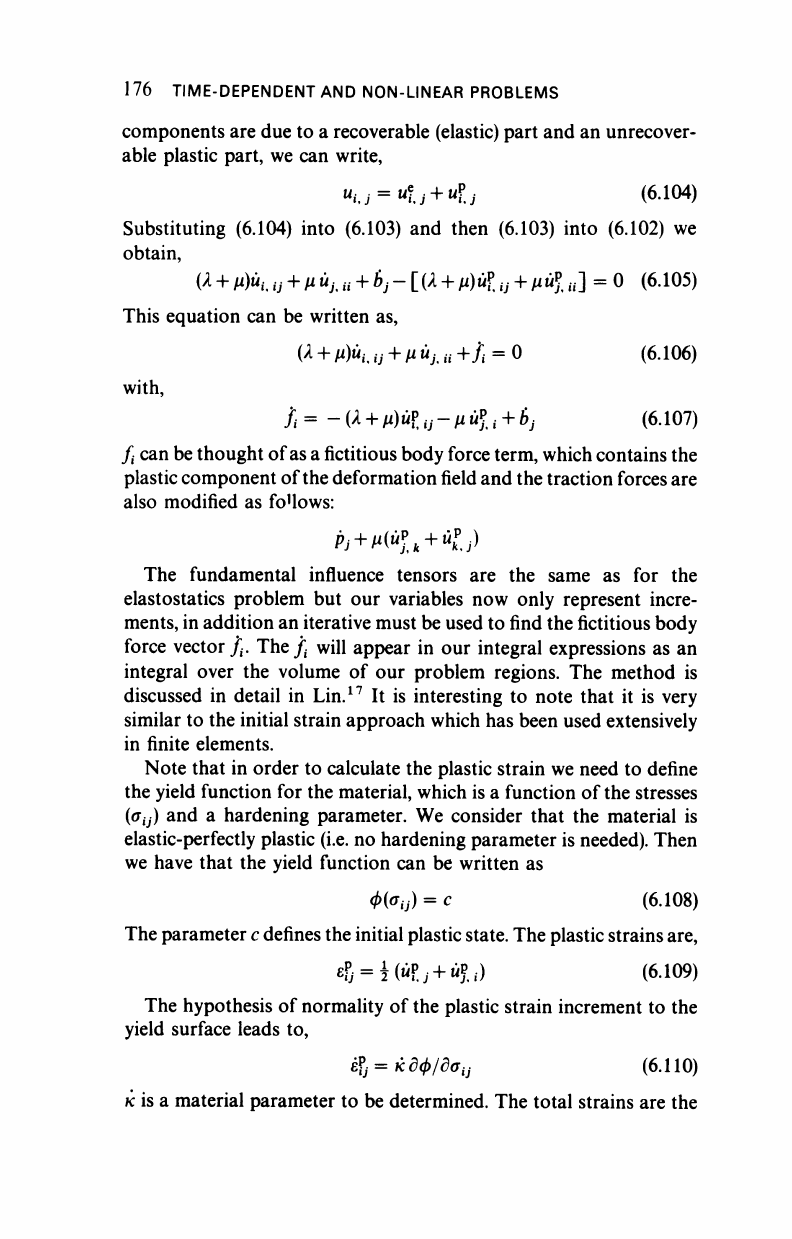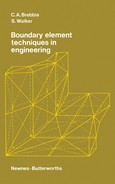
TIME-DEPENDENT AND NON-LINEAR PROBLEMS 175
Integrating by parts the weighted residual statement corresponding
to (a) we find that
| u*qdr+ q*udr- "* hp ) <& (c)
The last term involves the integration of our unknown function so
we cannot apply the boundary element method directly to this
equation. As our first approximation we choose u
0
= constant such
that
[-(
Jduo^
u*
I
-^ | dß = 0 (d)
and hence our first iteration u = u
l
will be given by the equation,
Cjtt'i = — u*<Zi
dr +
q*
Ul
dr
(e)
The following iteration u = u
2
will be given by
u*q
2
dr +
C:
U
["'-">'-l·"^'"
Ω
(0
and so on. For convergence we may require that the difference
between two successive values of u, or their norms, is small.
6.11 PLASTICITY AND SOIL MECHANICS PROBLEMS
One important application of the boundary element method to non-
linear problems is in the field of elastoplasticity.
The governing differential equations for the region of 'secondary
creep'
in elastoplasticity can be written
17
in terms of the incremental
equilibrium equation, i.e.
dx
^ + ^ = 0
(6.102)
where ( ) indicates stress rates. The stress rates are given by
°ij = ^iA,
k
+
μ(*5, i
+ »I
J)
(
6
·
103
)
Note that u) , are the elastic strain components. If the total strain

176 TIME-DEPENDENT AND NON-LINEAR PROBLEMS
components are due to a recoverable (elastic) part and an unrecover-
able plastic part, we can write,
".,, = <; +
"?,;
(6.104)
Substituting (6.104) into (6.103) and then (6.103) into (6.102) we
obtain,
(A
+ μ)Κ
u
+ μ uj
9
, +
i>j
- [(A + μ)ύΙ
u
+ μ^ ,] = 0 (6.105)
This equation can be written as,
(λ + μ)ώ
Μ
, + μώ
ΛίΙ
+./; = 0 (6.106)
with,
/
ί
=-(λ +
μ)ύΙ„-μύΙ
ί
+ 6
]
(6.107)
fi can be thought of as a fictitious body force term, which contains the
plastic component of the deformation field and the traction forces are
also modified as foUows:
P;+ /*(",%+ "'.;)
The fundamental influence tensors are the same as for the
elastostatics problem but our variables now only represent incre-
ments, in addition an iterative must be used to find the fictitious body
force vector
7).
The/
f
will appear in our integral expressions as an
integral over the volume of our problem regions. The method is
discussed in detail in Lin.
17
It is interesting to note that it is very
similar to the initial strain approach which has been used extensively
in finite elements.
Note that in order to calculate the plastic strain we need to define
the yield function for the material, which is a function of the stresses
(<T
0
)
and a hardening parameter. We consider that the material is
elastic-perfectly plastic (i.e. no hardening parameter is needed). Then
we have that the yield function can be written as
4>(G
tj
)
= c (6.108)
The parameter c defines the initial plastic state. The plastic strains are,
e&
= i("P.j + *?.i) (6.109)
The hypothesis of normality of the plastic strain increment to the
yield surface leads to,
έΙ = κδφ/δσ
υ
(6.110)
k is a material parameter to be determined. The total strains are the

TIME-DEPENDENT AND NON-LINEAR PROBLEMS 177
sum of the elastic and plastic components, i.e.
έο =
έ?,
+ έ,Ρ=έ?,. + ακ^- (6.Π1)
where
f 1 when φ ^ c
|0 when φ < c
Applying the chain rule to equation (6.108) gives,
do
-^-σ
0
= 0 (6.112)
Inverting equations (6.111) and (6.112) and assuming a = 1 we can
obtain the following stress relations:
iy^afj
+ o* (6.113)
The value of k is then known.
Note that the incremental equilibrium equations can also be
written as functions of the plastic strain components as
μώ,
JJ
+ (λ + μ)ύ
ί9
ij
+ Sj- (δ
υ
λ^ j + 2μβ&) = 0 (6.114)
The incremental elastoplastic treatment described above may be
approximated in some situations by an elastic analysis incorporating
non-linear stress-strain relations, with plastic yield modelled by yield
surfaces along which special yield elements are placed.
Wood
18
has obtained some impressive results on the settlement of
structures by coupling a simple plate finite element representation of
the foundation with a boundary element representing the soil. The
available analytic solutions were used for the force displacement
characteristics of a homogeneous elastic half space, to take account of
the heterogeneity in the soil the heterogeneous stress-strain relations
were used to obtain the surface displacements. This approach has
been shown to be surprisingly accurate.
In the field of underground excavations the boundary element
method has been adapted by Bray
19
and Hocking.
20
The non-
linearities in the soil are treated with an incremental approach as
described above and so the path dependence of the stresses in the
surrounding medium are taken into account. In addition special
'joint' elements are formulated to accommodate slip in faults in the
excavated medium. Bray uses fictitious forces to represent the release
of stress whereas Hocking uses a distribution of quadrupoles. The
..................Content has been hidden....................
You can't read the all page of ebook, please click here login for view all page.
